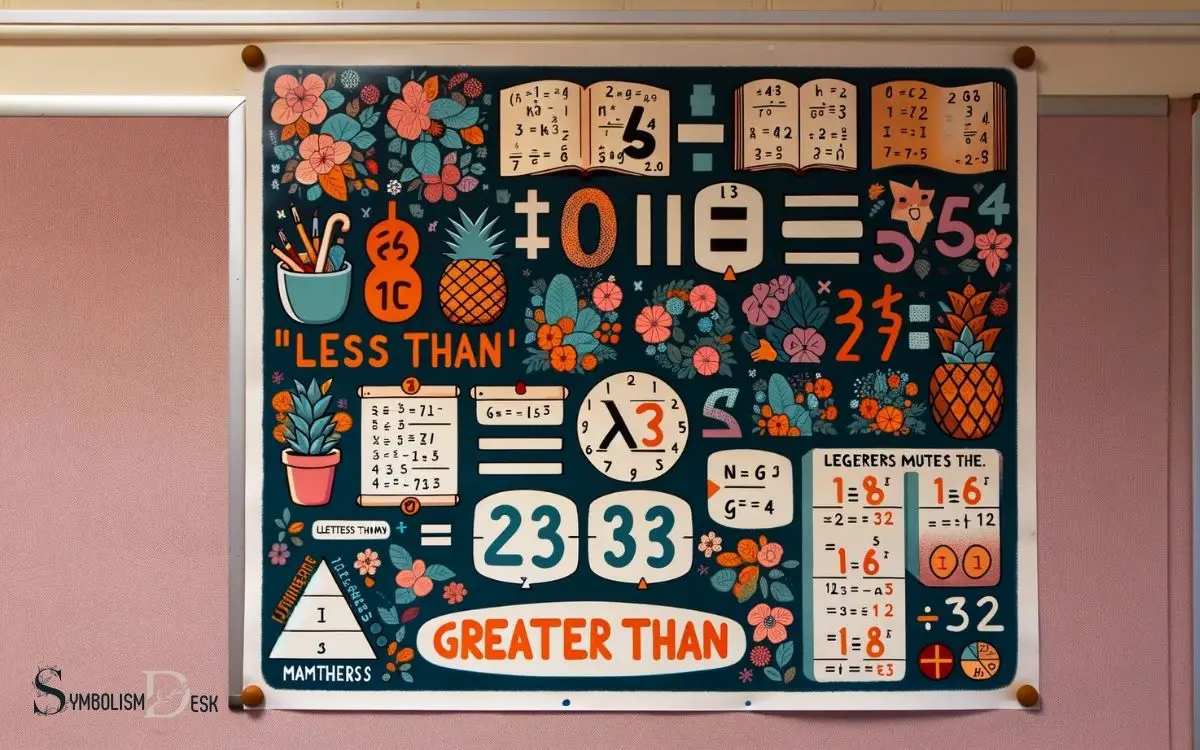Math Symbols Less Than and Greater Than: Opposite!
The math symbols for less than and greater than are “<” and “>”, respectively. These symbols are used to compare two values, indicating whether one is smaller or larger than the other
The “<” symbol denotes that the value on the left is less than the value on the right, while the “>” symbol indicates the opposite, with the value on the left being greater than the value on the right.
These symbols are foundational in mathematics for expressing inequalities and are used across various levels of math.
Here’s a short example to illustrate their use:
Understanding the less than and greater than symbols is crucial for solving inequality problems and represents a fundamental skill in mathematics.

Key Takeaway
Meaning of Less Than and Greater Than Symbols
The less than symbol (<) and the greater than symbol (>) are used in mathematics to compare two quantities and to show which one is smaller or larger.
When comparing two values, the less than symbol (<) is used to indicate that the quantity on the left is smaller than the quantity on the right.
Conversely, the greater than symbol (>) is used to show that the quantity on the left is larger than the quantity on the right.
These symbols are fundamental in mathematical expressions, equations, and inequalities, providing a clear and concise way to express the relationship between different values.
Understanding the meaning and application of these symbols is crucial for grasping mathematical concepts and problem-solving.
Origin and History of the Symbols
With the understanding of the meaning and application of the less than and greater than symbols established, delving into the origin and historical development of these mathematical symbols provides valuable insight into their evolution and widespread adoption.
The less than symbol (<) can be traced back to the work of Thomas Harriot, an English mathematician, in the early 17th century.
He used a “crooked figure” to represent inequality. The greater than symbol (>) is believed to have been introduced by the French mathematician Pierre Bouguer in the 18th century.
These symbols gained widespread acceptance and standardization within mathematical notation during the 19th century.
Their intuitive representation of relative size and value has contributed to their enduring use in mathematics, physics, engineering, and various other fields where quantitative comparisons are fundamental.
Rules for Using Less Than and Greater Than
Understanding the rules for using the less than and greater than symbols is essential in mathematics. These symbols denote comparison and inequality between numbers, and their meanings need to be grasped for accurate mathematical representation.
In this discussion, we will explore the meanings of these symbols, how to compare numbers using them, and their significance in expressing inequalities in mathematical equations.
Symbol Meanings Explained
When using the symbols for less than and greater than in mathematical expressions, one must understand their specific meanings and rules for usage.
These symbols have specific implications that must be followed to ensure accurate mathematical communication.
Here are some important rules to keep in mind:
- The symbol “<” represents “less than” and is used to compare two quantities, with the smaller quantity on the left and the larger quantity on the right.
- The symbol “>” represents “greater than” and is used to compare two quantities, with the larger quantity on the left and the smaller quantity on the right.
- When comparing quantities, it’s essential to ensure that the direction of the symbol points towards the smaller quantity.
- In equations, the symbols must be used with precision to accurately represent the relationship between the quantities involved.
Comparing Numbers Using Symbols
In comparing two quantities, the symbol ‘<’ denotes that the quantity on the left is less than the quantity on the right, while the symbol ‘>’ indicates that the quantity on the left is greater than the quantity on the right. For instance, if we have 5 < 8, it means that 5 is less than 8.
Similarly, if we have 10 > 3, it means that 10 is greater than 3. Understanding these symbols is crucial for comparing numbers and quantities in mathematics.
It enables us to express relationships between different values and make meaningful comparisons.
Mastering the rules for using less than and greater than symbols is fundamental for interpreting and solving mathematical problems.
Inequality Signs in Math
The application of inequality signs in mathematics involves precisely defining the relationships between numbers and quantities using the symbols ‘<’ and ‘>’. Understanding these symbols is crucial for comparing and ordering numbers.
Here are some key points to consider:
- The ‘<’ symbol represents “less than” and the ‘>’ symbol represents “greater than”.
- When comparing two numbers, the open side of the symbol always points to the smaller number.
- Inequality signs are used to express the relationship between two quantities, indicating which one is smaller or greater.
- In mathematics, the use of inequality signs is fundamental for expressing numerical relationships in equations and inequalities.
Understanding the rules for using these inequality signs is essential for solving mathematical problems and making accurate comparisons.
Applications in Arithmetic
Applying the symbols for less than and greater than in arithmetic allows for direct comparisons of numerical values. These symbols are essential for understanding relationships between numbers.
For example, in basic addition and subtraction, the symbols help determine which number is greater or smaller.
They are also crucial in multiplication and division, aiding in comparing the relative sizes of products and quotients.
Moreover, in more advanced arithmetic, such as working with fractions and decimals, the symbols play a fundamental role in comparing and ordering these values.
Understanding the concepts of less than and greater than in arithmetic is foundational for further mathematical learning, providing a basis for more complex problem-solving and mathematical reasoning.
As we delve into applications in algebra, these fundamental concepts will continue to be integral for building upon mathematical understanding.
Applications in Algebra
Utilizing the symbols for less than and greater than in algebra allows for direct comparison of algebraic expressions, aiding in the analysis of their relative magnitudes and relationships.
- Simplifying complex inequalities becomes more manageable.
- Solving equations involving inequalities is made simpler.
- Graphing linear inequalities on a coordinate plane becomes more intuitive.
- Comparing and ordering real numbers and variables is facilitated.
Understanding the implications of these symbols in algebraic expressions is fundamental for solving equations and inequalities, graphing functions, and analyzing mathematical relationships.
The ability to compare and contrast different algebraic expressions using the less than and greater than symbols is essential for making informed decisions in algebraic problem-solving.
Comparing Fractions and Decimals
When comparing fractions and decimals, precision and accuracy are essential for making mathematical distinctions.
It’s important to understand that fractions and decimals represent parts of a whole, and being able to compare them is crucial in various mathematical and real-world contexts. To compare fractions, it’s often necessary to find a common denominator to ensure accurate comparison.
When comparing decimals, aligning the decimal points is key to making accurate judgments. Understanding the relationship between fractions and decimals is fundamental in mathematics.
For example, being able to compare fractions and decimals is essential in tasks such as ordering quantities, comparing measurements, and analyzing data.
Mastery of this skill is vital for success in fields such as science, engineering, and finance, where precision is of utmost importance.
Common Misconceptions and Pitfalls
In comparing fractions and decimals, a common misconception is that aligning the decimal points is the only factor to consider for accurate judgments, leading to potential errors in mathematical comparisons.
To gain a better understanding of comparing fractions and decimals, consider the following common misconceptions and pitfalls:
- Misconception: Assuming larger decimal digits equate to a larger value.
- Pitfall: Forgetting to convert fractions to a common denominator before comparison.
- Misconception: Believing that the number of decimal places determines the size of a decimal.
- Pitfall: Neglecting to simplify fractions before making comparisons.
Understanding these misconceptions and pitfalls is crucial for accurately comparing fractions and decimals, ensuring that mathematical judgments are made with precision and accuracy.
Conclusion
The symbols for less than and greater than have a rich history and serve as essential tools in mathematics. They are used to compare numbers and quantities, and their applications extend to arithmetic and algebra.
By understanding the rules and applications of these symbols, students can avoid common misconceptions and pitfalls in their mathematical studies. In short, the less than and greater than symbols are indispensable in the world of mathematics.






